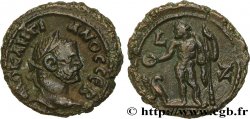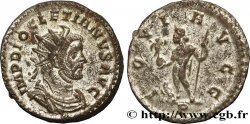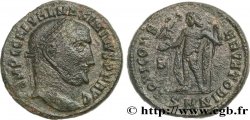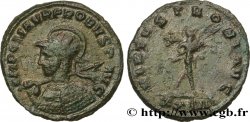E-auction 342-256646 - brm_173656 - DIOCLETIAN Aurelianus
You must signin and be an approved bidder to bid, LOGIN TO BID. Accounts are subject to approval and the approval process takes place within 48 hours. Do not wait until the day a sale closes to register. Clicking on « bid » constitutes acceptance of the terms of use of cgb.fr private e-auctions.
Bids must be placed in whole Euro amounts only. The sale will start closing at the time stated on the item description; any bids received at the site after the closing time will not be executed. Transmission times may vary and bids could be rejected if you wait until the last second. For further information ckeck the E-auctions F.A.Q.
NO BUYER'S FEE.
NO BUYER'S FEE.
| Estimate : | 150 € |
| Price : | 101 € |
| Maximum bid : | 101 € |
| End of the sale : | 04 November 2019 14:10:00 |
| bidders : | 5 bidders |
Type : Aurelianus
Date: automne 289 - début 290
Date: 289-290
Mint name / Town : Lyon
Metal : billon
Millesimal fineness : 50 ‰
Diameter : 22,5 mm
Orientation dies : 6 h.
Weight : 4,24 g.
Rarity : R3
Officine: 1re
Coments on the condition:
Exemplaire sur un flan parfaitement centré des deux côtés. Très beau portrait. Revers bien venu à la frappe. Patine grise avec des reflets métalliques, légèrement tachée
Catalogue references :
Predigree :
Cet exemplaire provient de ROME I, n° 46
Obverse
Obverse legend : IMP DIOCLETIANVS AVG.
Obverse description : Buste radié, drapé et cuirassé de Dioclétien à droite, vu de trois quarts en avant (A).
Obverse translation : “Imperator Diocletianus Augustus”, (L’empereur Dioclétien auguste).
Reverse
Reverse legend : IOV-I A-VGG/ -|-// P.
Reverse description : Jupiter nu debout à gauche, le manteau sur l'épaule gauche, tenant un globe nicéphore de la main droite et un sceptre long de la gauche ; à ses pieds, un aigle debout à gauche, détournant la tête à droite.
Reverse translation : “Iovi Augustorum”, (Au Jupiter des augustes).
Commentary
Poids lourd. Avec l’intégralité de son argenture superficielle. Rubans de type 3 aux extrémités bouletées. Ptéryges invisibles sous le paludamentum. Sur cet exemplaire, les traits de Dioclétien ressemblent à ceux de Maximien Hercule, déjà signalé pour le type Bastien Supplément III, n° 246f et g techn. dont l’exemplaire provenant de la collection Daniel Compas.








 Report a mistake
Report a mistake Print the page
Print the page Share my selection
Share my selection Ask a question
Ask a question Consign / sell
Consign / sell
 Full data
Full data












